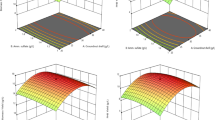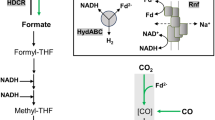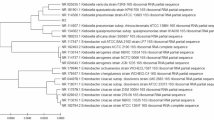Abstract
ORGANISMS which fix carbon dioxide can be used to advantage for the preparation of radioactive labelled compounds. During growth, radioactive carbon from 14CO2 can be incorporated into all cellular substances. If growth is inhibited, assimilated carbon is bound primarily in the form of reserve material. Several ‘knallgas’ bacteria of the Hydrogenomonas type incorporate 14CO2 into poly-β-hydroxybutyric acid (PHBA) in a hydrogen–oxygen atmosphere in the absence of a source of nitrogen1,2. PHBA can be depolymerized to D(—)-β-hydroxybutyric acid (HBA) by using either hydrazine3 or enzymatic hydrolysis4,5.
This is a preview of subscription content, access via your institution
Access options
Subscribe to this journal
Receive 51 print issues and online access
$199.00 per year
only $3.90 per issue
Buy this article
- Purchase on SpringerLink
- Instant access to full article PDF
Prices may be subject to local taxes which are calculated during checkout
Similar content being viewed by others
References
Schlegel, H. G., Gottschalk, G., and Bartha, R. von, Nature, 191, 463 (1961).
Gottschalk, G., Arch. Mikrobiol., 47, 236 (1964).
Ottaway, J. H., Biochem. J., 84, 11 (1962).
Schlegel, H. G., and Chowdhury, A. A., Naturwiss., 49, 502 (1962).
Chowdhury, A. A., Arch. Mikrobiol., 47, 167 (1963).
Schlegel, H. G., Kaltwasser, H., and Gottschalk, G., Arch. Mikrobiol., 38, 209 (1961).
Williamson, D. H., and Wilkinson, J. F., J. Gen. Microbiol., 19, 198 (1958).
Author information
Authors and Affiliations
Rights and permissions
About this article
Cite this article
GOTTSCHALK, G., SCHLEGEL, H. Preparation of 14C-D(—)-β-hydroxybutyric Acid from 14CO2 using ‘Knallgas’ Bacteria (Hydrogenomonas). Nature 205, 308 (1965). https://doi.org/10.1038/205308a0
Issue date:
DOI: https://doi.org/10.1038/205308a0
This article is cited by
-
Esters of phthalic acid as artifacts in bacterial lipids
Archiv f�r Mikrobiologie (1972)
-
Hydrolyse von PHBS durch intracelluläre Depolymerase von Hydrogenomonas H16
Archiv für Mikrobiologie (1967)



